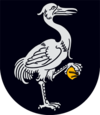Grobiņa
Grobiņa (![]() pronunciation (help·info); German: Grobin) is a toun in wastren Latvie, eleiven kilometres east o Liepāja. It wis foondit bi the Teutonic Knichts in the 13t century. Some ruins o thair Grobina castle are still visible. The toun wis gien its charter in 1695.
pronunciation (help·info); German: Grobin) is a toun in wastren Latvie, eleiven kilometres east o Liepāja. It wis foondit bi the Teutonic Knichts in the 13t century. Some ruins o thair Grobina castle are still visible. The toun wis gien its charter in 1695.
Grobiņa | |
|---|---|
Toun | |
| Coordinates: 56°32′N 21°11′E / 56.533°N 21.183°E | |
| Kintra | |
| Destrict | Grobiņa Municipality |
| Toun richts | 1695 |
| Govrenment | |
| • Mayor | Jānis Neimanis |
| Area | |
| • Total | 5.12 km2 (1.98 sq mi) |
| Population | |
| • Total | 3,977 (2,016)[1] |
| • Density | 776.8/km2 (2,012/sq mi) |
| Time zone | UTC+2 (EET) |
| • Summer (DST) | UTC+3 (EEST) |
| Postal code | LV-3430 |
| Cawin code | +371 634 |
| Nummer o ceety cooncil members | 9 |
Durin the Early Middle Ages, Grobiņa (or Grobin) wis the maist important poleetical centre on the territory o Latvie. Thare wis a centre o Scandinavie dounset on the Easter Seas, comparable in mony weys tae Hedeby an Birka but probably predatin them baith. Aboot 3,000 survivin burial moonds contain the maist impressive remains o the Vendel Age in Northren Europe.
Scandinavie dounset
eeditThe dounset pre-dates the Viking Age, but wis apparently uised as a place o passage bi Vikings frae the early 9t century.[2]
Steid
eeditThe dounset at Grobin wis excavatit bi Birger Nerman in 1929 an 1930. Nerman foond remains o an yirdwirk stranghauld, which haed been protectit on three sides bi the Ālande River. Three Vendel Age cemeteries mey be datit tae the period atween 650 an 800 AD. Ane o thaim wis militar in character an analogous tae seemilar cemeteries in Mälaren in Central Swaden, while twa ithers indicate that thare wis "a commonty o Gotlanders who wur carryin on peaceful pursuits ahint the shield o the Swadish militar".[3] Frae Nerman's fyndins, it appears that Grobin wis the steid o an early Scandinavie colony frae Gotland. Mony o the graves in level grund wur o weemen, who coud be identifee'd as natives o Gotland bi thair belt-buckles an brooches. The grave-moonds predominantly hoosed men, aften accompanee'd bi teepical Scandinavie weaponry.[2]
In ane grave a pictur-stane or stele depictin twa duck-lik birds wis foond in 1987. Sic pictur-stanes are itherwise unique tae Gotland. Frae its style it can be datit tae the seicont hauf o 7t century. The wathered surface o ane side contains refined carvins - inside the ring o ornaments thare are twa wtterbirds; thair beaks meet. Several hunders o sic pictur stanes (Swadish: bildsten) hae been foond in Gotland.[4]
In the early years o the 9t century female graves at Grobin acome scarce. Later graves are those o seafarin Scandinavie males.[5]
Destruction
eeditThe Norsemen mey hae remained in control o Grobin till the mid-9t century, when — as Rimbert's Vita Ansgari relates — fowk inhabitin the Courland regions o Latvie rebelled efter a lang period as tributars o Swadish rulers. In aboot 854 a fleet o Danes attemptit tae reimpose the tribute on thair awn behauf, but wis defeatit. Then Olof I o Swaden gathered an enormous airmy an tree'd tae win back the umwhile colony, in the process destroyin a place that Rimbert caws Seeburg, uisually identifee'd as Grobin. Seeburg haed 7,000 airmit men tae pertect it, but the toun wis pillagit, ravagit, an burnt bi the Swades. The invaders sent back thair ships an stairtit oot on a five-day expedeetion intae the hinterland. Thay reached the toun o Apulia (modren Apuolė, 25 mile tae the sootheast, in Lithuanie) which haed as mony as 15,000 warriors. The toun wis besiegit for aicht days athoot apparent success an the Norsemen even appealed tae the Christian God for help. When thay wur preparin for a decisive battle, the Curonians suddent sued for peace, givin as buity wappens an gowd captured bi thaim frae the Danes a year earlier.[6]
Nerman's excavations at the auncient fort o Apulia corroboratit the accoont o Vita Ansgari. He foond evidence o a lairge-scale conflict in the 9t century, notably lairge concentrations o Swadish arraeheids near the waws o the derelict Curonian fortress.
-
Grobiņa toun haw
References
eedit- ↑ «Latvijas iedzīvotāju skaits pašvaldībās pagastu dalījumā»
- ↑ a b Robert Ferguson, The Hammer and the Cross: A new history of the Vikings (2009), pp. 110-111.
- ↑ Francis Donald Logan. The Vikings in History (Routledge 1992), page 182.
- ↑ Priediens Scandinavian barrow cemetery
- ↑ Robert Ferguson, The Hammer and the Cross: A new history of the Vikings (2009), page 111.
- ↑ Rimbert: Life of Anskar, the Apostle of the North, 801-865, chapter 30.
Further readin
eedit- B. Nerman. Grobin-Seeburg, Ausgrabungen und Funde. Stockholm, 1958.

